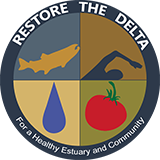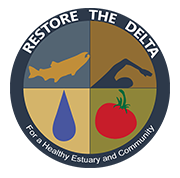For Immediate Release: Friday, June 27, 2014
Contact: Steve Hopcraft 916/457-5546; steve@hopcraft.com; Twitter: @shopcraft; @MrSandHillCrane; Barbara Barrigan-Parrilla 209/479-2053 barbara@restorethedelta.org; Twitter: @RestoretheDelta
NOT Tunnels Neutral,
Taxpayers Would Foot Bill for Tunnels Damage
Sacramento, CA – Restore the Delta (RTD), leading opponents of Governor Brown’s rush to build massive water export tunnels that mainly serve mega-growers in Westlands and Kern Water Districts, today rejected the governor’s assertion that his proposed state water bond principles are “tunnel neutral,” releasing proposed bond language that would have taxpayers foot the bill for the damage from the tunnels project. The tunnels cannot be built without hundreds of millions of dollars to fund “mitigation” of the project’s damage, damage the water-takers refuse to pay, and are foisting onto taxpayers.
“The governor’s water bond is not ‘tunnels neutral,’ and his declaring it so does not make it true,” said Barbara Barrigan-Parrilla, RTD executive director. “Much in the same way the proponents of the tunnels project named it the ‘Bay Delta Conservation Plan,’ (BDCP) and classified construction of the massive 35-mile long tunnels their primary ‘conservation measure,’ the governor is perverting the meaning of the English language. We are not fooled, and neither will the taxpayers who will pay the bill be fooled. This tunnels-enabling provision would doom the water bond we all need to address our water crisis.”
RTD released language from the Governor’s bond proposal exposing that his bond is not tunnel neutral. The governor’s proposed Chapter X. Watershed Protection and Ecosystem Restoration, Section 79735 B, provides that funds will be made available for ‘habitat restoration’ that is part of the BDCP plan, and for moving water from willing sellers to habitat areas, a program that would have taxpayers pay to replace the required water flows exported by the BDCP tunnels.
RTD released BDCP records obtained through the Freedom of Information Act showing that the BDCP plans to use bond funds to help fund purchases over the next 50 years of up to 1.3 million acre feet of water annually from upstream areas, such as the Sacramento Valley. “These purchases are needed to make up for over-pumping by the new water export Tunnels,” said RTD consultant Steve Hopcraft. “Having taxpayers fund the replacement of Sacramento River and other water taken by the tunnels is an underhanded, back-door program required to mitigate the damage the tunnels would cause. They can’t get the needed permits without the mitigation. How is that “tunnels neutral?” The governor’s own poll shows that the water bond will lose if it is a referendum on the tunnels project. This provision would be a poison pill and would undermine an otherwise valuable bond measure. We don’t want to campaign against the water bond, because we need to put in place sustainable water policies. But we won’t sit by and let the governor mislead taxpayers and pretend this funding is not part of the tunnels financing plan. Just read the language being proposed in his bond and put 1 + 1 together. The tunnels are not worth tubing the entire bond, and we urge the legislature to remove this provision and leave the fight over the Delta tunnels for another day.”
In bond provisions labelled as BDCP ‘restoration’ and ‘habitat’ funding, the public would pay to purchase so-called ‘enhanced environmental flow’ water from previously identified districts in the Upper Sacramento River Basin. This would devastate their groundwater supplies. That same water would be diverted into the new BDCP Tunnels before it flows into the heart of the Delta.
RTD also released a document obtained through a Public Information Act request prepared by the State Water Contractors Authority entitled “Stradling Yocca Carlson and Rauthm.” The February 2014 document spells out that at this time, there is no financing plan for the BDCP-DHCCP peripheral water tunnels project. According to the BDCP-DHCCP public draft, “[s]eparate financing plans, funding agreements, legislative authority, and other documents will be needed to enable the use of certain funding sources.” The success of the project relies on as yet unfunded $4.1 billion dollars from the California State General Fund [17%] and $3.6 billion from federal taxpayers [14%].
BDCP proponents need this water bond to begin putting the pieces in place to secure the financing for the project. The Brown administration knows this, and is trying to bury this funding in their proposed bond under watershed protection and is misleading the public describing a “tunnel neutral” bond.
“What can be worse for Californians than not being able to trust the Governor to tell us the truth about what funds will be used for in his proposed water bond during a period of extreme drought?” asked Barrigan-Parrilla.
From the governor’s proposed water bond:
Chapter X. Watershed Protection and Ecosystem Restoration
79731. This chapter implements activities in action numbers 4 and 9 of the California Water Action Plan.
79732. The sum of one billion four hundred fifty million dollars ($1,450,000,000) shall be available for the purposes of this chapter.
79733. Projects eligible for funds provided in Section 79732 shall be available upon appropriation by the Legislature for projects that protect and restore rivers, lakes and streams, their watersheds and associated land, water, and other natural resources.
79734. Of the funds provided in Section 79732, six hundred fifty million dollars ($650,000,000) shall be available for appropriation to the Natural Resources Agency.
79735. (a) The secretary may directly grant such funds in 79734 to any nonprofit organization, conservancy, public agency, or any tribal government or community for activities and programs that are consistent with and would further existing obligations in state settlement agreements or any authorized amendment thereto that achieve the ecological goals described in the California Water Action Plan.
(b) Funds may be used for projects that help fulfill state obligations to wildlife refuges and wildlife habitat areas under Section 3406(d) of Title 34 of Public Law 102-575, including the construction, retrofitting, and maintenance of water supply infrastructure and the acquisition and conveyance of water supply from willing sellers for water transfers of not less than 20 years, purchases of water rights, or other agreements that result in long-term enhancement of habitat conditions.
79736. (a) Of the funds provided in Section 79732, eight hundred million dollars ($800,000,000) shall be available, upon appropriation by the Legislature, to the State Board and the Department of Fish and Wildlife for vital species, habitat, or ecosystem restoration activities statewide and to achieve the protection of water related species and water quality. The State Board or the Department of Fish and Wildlife may directly grant to any nonprofit organization, conservancy, public agency, or any tribal government or community for activities under this section.
(1) Of the funds provided for in this section, at least $200 million shall be made available for the enhancement of water flows in stream systems statewide. These funds may be used to acquire water if (i) the acquisition involves a long-term water transfer for a term of not less than 20 years, a purchase of water for instream use, or other agreement that results in enhanced stream flow such as reservoir
reoperation or conjunctive use programs, and (ii) the Department of Fish and Wildlife determines that the acquisition, purchase, or agreement and the use of funds will provide fisheries or ecosystem benefits or improvements that are greater than required environmental mitigation measures or compliance obligations. The department shall consult with the State Board prior to making such a determination.
(2) Of the funds provided for in this section, at least $200 million shall be made available for ecosystem restoration for projects statewide. These funds may be used to fund coastal wetland habitat, watershed restoration, including activities to improve forest health, restore mountain meadows, modernize stream crossings, reconnect historical flood plains, install or improve fish screens, provide fish passages, restore river channels, restore or enhance riparian habitat, and remove sediment or trash. In allocating funds for projects pursuant to this paragraph, the State Board and Department of Fish and Wildlife shall consider the location of projects such that funded projects are geographically distributed throughout the state.
(b) Where it will either limit the cost of administering an activity under this chapter, increase the efficiency and effectiveness of an activity under this chapter, or will prevent unnecessary delay in its implementation, the Department of Fish and Wildlife shall use existing programs or procedures when implementing this section, and shall contract with the State Board for technical assistance and to aid in implementation of this chapter.

